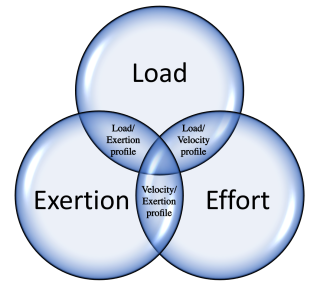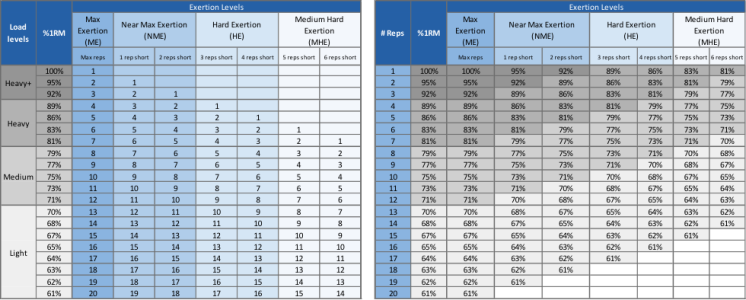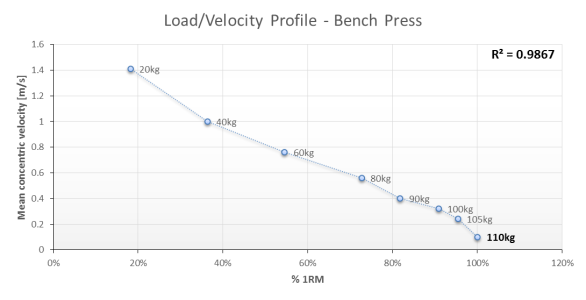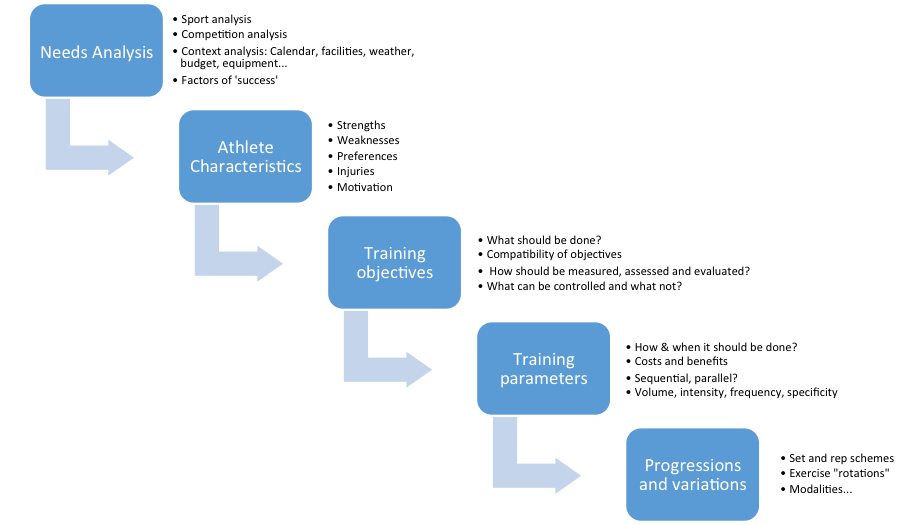Speed Training How to Develop Your Maximum Speed for Martial Arts Pdf
Strength Grooming Reps and Sets Schemes


Force Training Reps and Sets Schemes
This is probably the best article that I wrote and so far. It was originally written and published for EliteFTS website in two parts. Savour!
Training objectives -> Preparation parameters -> Variations & progressions
Regardless of your training objectives (increasing strength in specific lifts, increasing strength overally, bulking upward, leaning out, rehabilitation, maintenance, etc), the key training parameters (intensity, volume, frequency, density) could be varied and progressed on different time scales.
Certain variations and progressions in preparation parameters are more suited towards different training objectives, only there are commonalities betwixt them that nosotros will focus on in the current article.
Preparation parameters unremarkably involve intensity, volume, frequency and density that could be analyzed and varied on different time-scales, and taking all of them into account would need a whole volume. Hence, the aim of the electric current article is to provide an overview of the common variations and progressions in intensity and volume only by manipulating force training reps and sets schemes on dissimilar time-scales (unmarried workout, week, training block). I know this sounds like a mouthful, but in the next couple of pages everything will be perfectly clear.
Understanding "intensity"
Depending on whom yous enquire, in that location are couple of definitions of training intensity. To cutting the long story short, I will present what I think to be a pretty neat manner to understand training intensity and reconcile different definitions and opinions. In my opinion, intensity has the post-obit three components.
Effort – relates to the athlete'south intent to perform a repetition of a given practise with maximum possible acceleration and speed in the concentric phase. The effort could be maximal (the synonym would be C.A.T. – compensatory acceleration training), or it could exist submaximal (lifting with a certain tempo).
Exertion – relates to the proximity of failure in a given set. It seems reasonable that the caste, or level of exertion is substantially different when performing, e.thou., viii out of 12 possible repetitions (12RM) with a given load (eight[12] or 8 of 12), compared with performing maximum number of repetitions (12[12] or 12 of 12). Exertion, in strength coaches' jargon, is usually expressed equally "reps left in the tank". Using the previous example, performing 8 reps with 12RM load represents submaximal exertion with 4 reps left in the tank. Performing 12 reps with 12RM represents maximal exertion with no reps left in the tank.
All three represent inter-related components of grooming intensity. I dear to call information technology Intensity Trinity.

Now you lot take the tool to respond the questions such as "What is more intensive – lifting ninety% for 2, or lifting 75% for 10?" Hint: 1 involves higher load, and some other involves higher exertion.
Understanding Load/Max Reps relationship
All lifters are familiar because they can merely perform a sure maximal number of reps with a sure load on the bar. If we limited load on the bar as a percentage of maximal load that could be lifted (% 1RM) and we assume maximal exertion on the last rep (no reps left in the tank), nosotros get Load/Max Reps relationship. Numerous tables quantify this relationship, simply for the purpose of this article, I will apply Dan Baker's tabular array for experienced trainers.

Using this table, one can know how many maximal reps tin can exist performed using a certain load (% 1RM). Also, ane can predict maximal load that tin can be lifted (1RM) using maximum performed reps and reconverting factor. For case, if one performs 10 reps with 225lb, his predicted maximum is 225×i.33 (reconverting factor), which is around 300lb. Please annotation that this table is different for different lifters and lifts, so take this as a rule of thumb and try to create your ain tabular array [ane].
Agreement Load/Exertion relationship
A Load/Exertion relationship is another crucial concept for understanding force training. From the Load/Max Reps table, we know the maximum number of reps that can be performed using different loads. This, of course, represents maximal exertion. What we want to exercise next is to quantify the relationship between load, number of reps, and exertion level (expressed as reps left in the tank).
The post-obit table is i such solution of using the mentioned Load/Max Reps from Dan Bakery. I simply call information technology Load/Exertion table.

Even if you encounter two tables, this is merely one table organized in 2 ways for easier utilization. For example, if one plans to utilise 75% of 1RM but is non certain what number of reps should exist performed for a given exertion level, the table on the left tin can give him an answer. On the flip side, if 1 plans to do 5 reps per gear up but is not certain what % of 1RM to use for a given exertion level, the tabular array on the correct tin can give him the answer.
The Load/Exertion table represents a crucial concept for understanding different variations and progressions (or sets and reps schemes) we are going to cover.
Agreement Load/Velocity relationship
Suppose that one performs single repetitions across range of loads (e.g. from 30 to 100% 1RM) with maximal effort. The higher the load, the lower the achieved velocity of the movement in the concentric range.

What is interesting is that the Load/Velocity human relationship could be modeled with a simple linear model (a.k.a. a line with slope and intercept) and remains very stable across fourth dimension. This means that 80% of 1RM will take very similar velocity in plain English language, no thing the change in 1RM (increased or decreased). Along with that, velocity associated with 1RM (east.m., 0.fifteen m/south for demote press and 0.3 m/s for squat) is very like across subjects with different 1RMs and very stable across time (if one improves or decrease his 1RM). This opens upwardly a great number of options for coaches.
Understanding Velocity/Exertion human relationship
Suppose that 1 performs reps to failure across different loads (due east.m. 50, 70, 90% 1RM) with maximal endeavor. There are a couple of VERY interesting concepts emerging.
The start one is that the last rep's velocity in a gear up to failure (regardless of load apply) is very similar, if not the aforementioned, as velocity associated with 1RM. In other words, the final rep in the 10RM gear up will have a very similar velocity to the 1RM rep.
The 2nd i is that velocity associated with "reps left in the tank" (exertion level) will be very similar across loads. In plain English, my eightthursday rep with 10RM load (2 reps left in tank) will have very similar velocity to my 4th rep with 6RM load (ii reps left in tank).
Load/Velocity and Velocity/Exertion relationships. Therefore, profiles for each athlete represent novel and powerful concepts utilized in velocity-based forcefulness training way to prescribe, monitor, and automobile-regulate strength training.
These ii relationships are of non of peachy importance for the electric current commodity (since we are going to comprehendstrength grooming reps and sets schemes with traditional approach to strength training prescription), simply those who are interested in learning more can click HERE.
Understanding "traditional arroyo"
The traditional approach, as I love to telephone call percent-based approach, involves prescribing forcefulness training past using percentages and known (or estimated) 1RM of the lifter.
The whole procedure goes like this: athlete knows his 1RM in a particular do, or he tests it either using a 1RM test or reps-to-failure test and estimates 1RM using reconversion factors (encounter Load/Max Reps table). Then he uses percent-based programs (e.g., 5×5 with 75%) and converts percentages to accented loads (e.1000., 5×5 with 120kg). And and so he goes lifting for a couple of weeks. Then either increment 1RM for some small amount (e.g., 5lb) or test it, either with 1RM test or with an open fix (basically reps-to-failure, usually done on the last set inside the grooming program/cycle). Rinse and repeat (or switch to another program).
Without going into too many details, at that place are a lot of problems with this approach. In that location are solutions, also.
The biggest problem is the lack of adjustment for dissimilar rates of changes for different lifters. Another problem is the lack of auto-regulation on a daily basis, for both good and bad days.
I of the simplest solutions is prescribing ranges for either load or number of reps. For instance, instead of prescribing 5×v with 75%, i could prescribe 5×5 with 70-80% or 5×iv-6 with 75%. This takes into account adept or bad days and reduces daily expectations and anxieties of the lifter for hitting certain numbers.
A flake more circuitous solution is using subjective feedback for exertion level for each set. This involves prescribing exertion levels and omitting either load or number of reps. Mike Tuchscherer, world-class powerlifter, developed the whole system revolving around RPE (Rating of Perceived Exertion), which is an easy way to quantify exertion level (RPE10 = no reps left in the tank, RPE9 = 1 reps left in the tank, RPE8 = 2 to four reps left in the tank and so forth). So, instead of prescribing verbal load and reps, one could prescribe load and exertion level (3 sets with 80% @RPE8) or a number of reps and exertion level (3×5 @RPE8).
More than attuned lifters can utilize this subjective feedback (rating of perceived exertion) to machine-regulate on good and bad days and adjust for individual rates of change in the force. It takes time and hard piece of work (and a lot of trial and mistake) to develop such knowledge.
The novel method involves using velocity-based strength grooming prescription and command. Describing this arroyo is beyond this article'southward scope, just in brusk, it revolves around prescribing initial rep velocity and velocity stop, instead of %1RM and number of reps. Again, for more information click Here.
Even with all these flaws, traditional or percent-based approach is still the most dominant approach to strength preparation. It was important to introduce the above relationships betwixt load, exertion, and effort, along with the problems of the pct-based approach to get the large picture. Nevertheless, for the residual of this article, we volition focus on common variations and progressions (sets and reps schemes) under a percent-based umbrella.
Overview of the process
As I have alluded to in the start of this commodity, grooming objectives will demand certain training parameters within which we can use various progressions and variations, termed strength training reps and sets schemes.
The whole process looks like this:

This is the simple procedure (information technology is definitely not linear every bit depicted, only involves a lot of feedback information to redefine certain components based on real-life results ~ hence the importance of monitoring and measuring) that outlines the planning and programming of training.
On the post-obit table, in that location is example breakdown of these processes for an intermediate powerlifter.
| Process | |
| Needs analysis | High level of strength in demote, squat and deadlift. Maintain bodyweight. iii months to competition. Low upkeep. Public gym access. |
| Athlete characteristics | Skillful bench presser. Bad back. Highly motivated. Loves training in group. No feel with gear (trained raw) |
| Preparation objectives | Fix the bad back. Maintain demote press operation. Learn to use gear. Improve squat and deadlift. |
| Grooming parameters | Train 5x/week. Do bench press 2x/wk at the finish of practices. First 2 months work on weaknesses, last month work on strength and practise contest lifts. Loftier frequency approach. Piece of work on squat/DL every training day. |
| Progressions and variations | Flat loading kickoff to accumulate volume. Switch to step loading. |
This is simply an instance without too many details (especially in grooming parameters and progressions), but I hope yous go the picture.
Equally alluded at the beginning of this commodity, certain variations and progressions in training parameters are more than suited towards different training objectives. Still, there are commonalities between them that we volition focus on. Thus, regardless of what you are training for (training objectives), there are sure strength training reps and sets schemes (progressions and variations) you lot tin employ on unlike time scales.
I will be relying on various writings by Dan Baker, Ashley Jones, Joe Kenn, and others in this classification and terminology. Please come across the references for further details.
Conditioning sets and reps schemes
Within this time frame, workout sets and reps schemes refer to one exercise and one workout. Here are couple of variations that are ofttimes done in strength training.
| Plateau Load | 5 x 5 @ 75% |
| Step Load | one x 5 @ 65%, one x 5 @ seventy%, ane ten 5 @ 75%, i 10 5 @ 80%, 1 x five @ 85% |
| Step Load plus Dorsum Off | 1 10 5 @ 65%, 1 x v @ seventy%, i x five @ 75%, 1 x five @ 80%, one x 5 @ 85%, 3 x 5 @ 65% |
| Reverse Pace Load | one ten five @ 85%, 1 x five @ 80%, 1 x five @ 75%, one x 5 @ seventy%, 1 ten v @ 65% |
| Traditional Pyramid | 1 x x @ 70%, 1 ten viii @ 75%, i x 6 @ 80%, one x 8 @ 75%, 1 ten ten @ 70% |
| Opposite Pyramid | 1 x vi @ 80%, 1 x viii @ 75%, 1 x 10 @ 70%, 1 10 8 @ 75%, 1 10 6 @ eighty% |
| Ascending Half Pyramid – Light to Heavy | i x x @ 70%, 1 10 viii @ 75%, 1 10 6 @ fourscore% |
| Descending Half Pyramid – Heavy to Light | 1 ten 6 @ 80%, 1 x 8 @ 75%, 1 10 10 @ seventy% |
| Ascending Rep Pyramid | one ten iv @ 70%, 1 x 5 @ seventy%, 1 x half dozen @ 70%, i x 7 @ 70%, i ten 8 @ seventy% |
| Descending Rep Pyramid | 1 x 10 @ 70%, 1 x 9 @ 70%, i x viii @ 70%, 1 x 7 @ lxx%, 1 x half dozen @ 70% |
| Standard Set Wave | ane x 10 @ 60%, 1 x x @ 67.5%, 1 x x @ 65%, 1 ten 10 @ 72.5% |
| Ascending Half Pyramid Wave – Light to Heavy | 1st Wave: ane x 10 @ 70%, 1 x viii @ 75%, 1 x vi @ fourscore% second Wave: i x 10 @ 72.5%, 1 x 8 @ 77.v%, ane ten 6 @ 82.5% |
| Descending Half Pyramid Moving ridge – Heavy to Light | 1st Wave: ane x 6 @ 80%, 1 ten 8 @ 75%, 1 x ten @ 70% 2nd Wave: 1 x vi @ 82.5%, i ten viii @ 77.five%, 1 x ten @ 72.v% |
| Stable Heavy to Light | 1 x 1 @ 90%, 1 x half dozen @ 75%, one x 1 @ 90%, i 10 6 @ 75% |
| Ascending Heavy to Light | ane x ane @ 90%, 1 10 6 @ 75%, one x i @ 95%, i 10 6 @ 80% |
| Descending Heavy to Lite | 1 ten i @ 95%, one x half dozen @ 80%, one x i @ ninety%, 1 x vi @ 75% |
| Cluster Sets | iv –5 x v x 1 @ 3RM load with 15 seconds rest in between each rep |
| Rest Pause/Myo Reps | fifteen-20+5x @ l% load with 15 seconds rest in between each ready |
| Daily Max plus Dorsum Off | 1 ten v @ 60, i ten 3 @ 70%, 1 ten 2 @ 80, 1 ten ane @ 90%, one x 1 @ xc+, 3-5 x two-3 @ 80-xc% |
| One Set Special | 1 ten 5 @ l%, 1 x 4 @ 60%, 1 x 3 @ 70%, 1 ten 2 @ eighty%, 1 ten 3+ @ 90% |
| Progressive Load | 1 x 2 @ 70%, 1 x 2 @ 75%, 1 ten 2 @ 80%, 3 10 4 @ 85% |
| Joe Kenn Moving ridge | i x 2 @ 75%, one x 4 @ 85%, 1 10 two @ 75%, 1 x 4 @ 85% |
| Joe Kenn Wave-3 | one x two @ 75%, 1 x two @ 80%, 1 x iv @ 85%, 1 10 2 @ 75%, 1 x ii @ fourscore%, 1 x 4 @ 85% |
In that location is ever a trouble with the terminology, but I used names by Ashley Jones and Joe Kenn. Certain variations are more suitable for certain periods and objectives than others. Certain variations progress on Load/Exertion tabular array by keeping reps the same and progressing in load and exertion, some vary reps and go along the same exertion, etc.
One tin also use different strength training reps and sets schemes for the same objective at dissimilar training phases (e.thousand. plateau load in accumulation phase, step load in intensification stage). The options are endless. The cardinal is having objective on listen, but however providing sure variability to avoid boredom at to the lowest degree, or providing stronger stimuli. Certain athletes will merely prefer certain variations. For case, I just detest plateau load option ~ I can do lot more work with wave approaches with same "mental load".
Weekly sets and reps schemes
Next progression and variation time frame is i grooming week (or microcycle). Depending on number of preparation sessions in a week and training frequency (how many times nosotros hit preparation objective, body part, muscle, biomotor power), we devise unlike variations. In the table below, based on work by Dan Baker, we can find unlike variations for two sessions, hitting the squat pattern (this could exist any other movement, torso part or grooming objective).
| Method of variation | Day 1 example | Day 2 example |
| 1. Same exercises and other variables, increase repetitions, and decrease resistance | Squat 3 × 10 @ lxx% | Squat 3 × 15 @ lx% |
| two. Same exercises and other variables, increase or decrease the number of sets. | Squat 4 × 10 @ 70% | Squat ii × x @ 70% |
| 3. Same exercises, sets, and repetitions, reduce the lifting speed and resistance. | Squat three × ten @ 70% | Squat 3 × ten @ 50% (4s/rep) |
| 4. Same exercises and other variables, subtract rest periods and resistance | Squat three × x @ 70% (3min/rest) | Squat three × x @ l% (1min/rest) |
| 5. Same exercises and other variables, subtract resistance. | Squat iii × 5 80% | Squat iii × 5 @ 70% |
| 6. Same exercises and other variables, subtract repetitions. | Squat 3 × five @ eighty% | Squat 3 × 2 @ 80% |
| seven. Different force exercises, but same for all other variables (same %1RM). | Squat iii × 10 @ seventy% | Forepart squat 3 × 10 @ lxx% |
| 8. Perform a strength and power version of aligned exercises on different days. | Squat 3×5 @ lxxx% | Spring squat 3 × 5 @ 40% |
| 9. Perform heavier and lighter versions of aligned ability exercises on dissimilar days. | Power clean 3 x five @ 70% | Power snatch 3 ten 5 @ 70% |
| ten. Same exercise, sets, and repetitions, different muscle regime | Squat three x five @ eighty% | Squat 3 x v @ lx% (3s isometric hold at 3 positions) |
| 11. Same exercise, sets, and repetitions, different modalities | Squat 3 x 5 @ 80% | Squat iii 10 v @ 60% + chains/bands |
| 12. Same exercise, sets and repetition, different ROM | Squat 3 x 5 @ fourscore% | 1/4 Squat three x 5 @ 80% |
One frequent application of weekly variations is the Difficult/Medium/Like shooting fish in a barrel approach of Bill Starr or ME/DE (Maximal Try, Dynamic Effort) of Westside.
With a higher frequency of workouts, 1 tin can choose different combinations of the variations. Certain variations are preferred based on fatigue cycles during the week (biological science), priorities (objectives & biology), constraints (context), or just plain preference.
Depending on the workout sets and reps schemes selected, weekly variations can take much more variety (e.g., weekly variations for plateau vs. step loading).
It is also important to say that not all exercises should follow the same variation. For example, lower body movements can use variation five or 6, while the upper body can use 1 or 3. This depends on the objectives, individual characteristics, and preferences.
Training cake sets and reps schemes
This is what Dan Baker calls "Unlike Cycle-Length Variants or Patterns of Periodized Strength Training." Other coaches recognize it equally Periodization Schemes. Unfortunately, about misfile training objectives (due east.one thousand., strength, power, hypertrophy, lockout strength, grip forcefulness, pigsty strength, etc.) and training blocks sets and reps schemes. For the sake of this article, I will assume the aforementioned training objective(s) over-training block and only focus on sets and reps schemes.
This manner, we volition avoid disruptive sets and reps variations and training objectives accent (e.g., undulating periodization sometimes utilizes the post-obit weekly schemes of 4 x 10, 4 x 6, iv 10 viii, 4 x 4, and that approach not only provides variety but also hits different training objectives like hypertrophy and strength). It is important to differentiate to different ways to 'attack' training dissimilar objectives (east.g., parallel, sequential, undulating, whatever fancy proper name in that location is today) and block sets and reps schemes variations aimed at 'attacking' the SAME training objective.
On the following table there are frequent variations utilizing different 'progressions' on Load/Exertion table. Don't mind the names, only try to go the underlying principles in load progression and variation.
| Name | Week | 1 | 2 | 3 | 4 | 5 | half dozen | 7 | 8 |
| Abiding | Same reps, same sets, increase load and exertion | 3×8 | iii×eight | three×viii | 3×8 | iii×eight* | 3×viii | 3×8 | iii×8 |
| "Traditional" | Same reps, high to low sets, increase load and exertion | 6×8 | 5×8 | 4×8 | three×8 | 6×8* | 5×eight | 4×8 | three×viii |
| Rep Accumulation | Same load, aforementioned sets, increase number of reps and exertion | three×8 | three×9 | 3×x | iii×11 | 3×8* | 3×ix | three×ten | 3×11 |
| Linear | Same sets and exertion, decreasing number of reps, load increase | iii×five | 3×iv | 3×iii | 3×ii | three×5* | iii×4 | 3×three | 3×2 |
| Linear Decreasing | Same sets and exertion, increasing number of reps, load decrease | 3×2 | 3×3 | 3×4 | 3×5 | 3×2* | 3×3 | 3×4 | 3×5 |
| Traditional & Linear | Aforementioned exertion, decreasing number of reps and sets, load increase | half dozen×five | v×4 | four×3 | 3×2 | 6×five* | five×4 | iv×three | 3×ii |
| Linear with exertion increase | Same sets, decreasing number of reps, load and exertion increment | iii×v | three×4 | 3×iii | 3×two | iii×v* | three×4 | 3×3 | 3×2 |
| Traditional Linear with exertion increase | Decreasing number of reps and sets, load and exertion increment | 7×v | 5×4 | three×3 | i×2 | 7×five* | five×4 | 3×3 | ane×2 |
| Accumulation/Intensification | Phase i: Rep accumulation Stage 2: Traditional & Linear | 6×3 | 6×4 | six×v | vi×6 | v×five* | four×4 | three×3 | two×ii |
| Constant with unload | Abiding with 4th calendar week unload | 3×8 | iii×eight | 3×8 | iii×8 | 3×8* | 3×8 | 3×8 | 3×8 |
| Linear with unload | Linear with 4th calendar week unload | 3×5 | 3×4 | 3×3 | three×4 | 3×5* | 3×4 | 3×iii | 3×four |
| Undulating | Undulaitng reps progression and intensity, same sets and exertion | 3×10 | 3×6 | 3×viii | 3×four | 3×x* | iii×half-dozen | 3×8 | iii×4 |
* Represents increase in 1RM (eastward.g. for two-5kg)
In that location are many more progressions and variations, but these are the common ones that are utilized under the aforementioned training objective. Don't hang up too much on this table, but utilise it equally an example. The tabular array refers to plateau loading in the conditioning, merely the principles could be applied to all other conditioning sets and reps schemes.
Please note that in that location could be different progressions for unlike training days (e.g., in weekly variation, twenty-four hours 1 could progress using a traditional and linear progression, and day two could progress using rep accumulation) and even different exercises (e.one thousand., main lifts could utilise different progression than aid). This makes an space number of combinations one could cull from. Again, for certain objectives or even exercises, we could prefer one block progression over another.
Hopefully, this article provided an overview of the "traditional" (pct-based) approach to strength training, with its different processes and different reps, and sets progressions and variations on the conditioning, week, and block time frames.
How to Implement This in "Real Life"?
Since the time this article was published on EliteFTS, I was working on translating the above-mentioned set and rep schemes into a prepare-to-use Excel template for both team/group workout and individual programs.
The good news is that nosotros take recently released a newly redesigned version of Forcefulness Card Builder, which now includes more than 1900 ready and rep schemes from theStrength Grooming Manual Books (Book one & Volume 2).
Here are the PDF previews of the Strength Bill of fare Builder outputs:
- Private card
- Group card – portrait (12×viii)
- Grouping card – landscape (vi×x)
If you want to know more about SCB, check out the two short videos below:
Demo Video (version v.0)
Instructional Video (version v.0)
The new version of SCB can be downloaded for free by Premium members, every bit well as Standard members who have been in our community for over a yr. All Standard members who are with us less than a year will likewise be able to download SCB free of charge, as soon as they fulfill the condition above.
If you are currently non a Complementary Training community member, I would like to invite yous to become one.
Source: https://complementarytraining.net/set-and-rep-schemes-in-strength-training/


0 Response to "Speed Training How to Develop Your Maximum Speed for Martial Arts Pdf"
إرسال تعليق